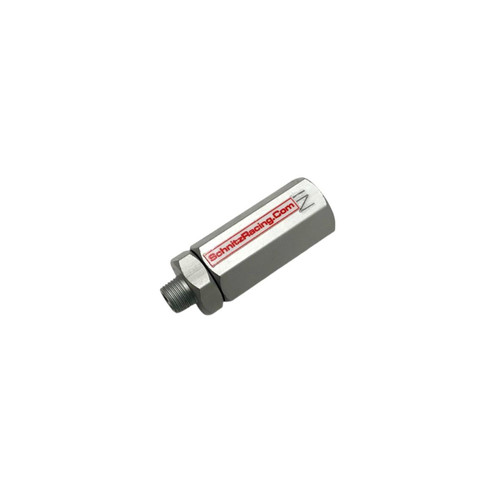Product Description
Replacement Air Shifter Solenoid – Junior & Deluxe
Need a new air shifter solenoid? This one's perfect for replacing a worn-out one or even building your own air shifter setup from scratch.
- Junior Solenoid: Uses 1/4" air line – this is the most common size and works great for most sportbikes.
- Deluxe Solenoid: Uses 3/8" air line – usually found on pro-level dragbikes.
To keep your solenoid running smoothly and lasting longer, make sure the air going in is filtered down to 40 microns. We’ve got air filters available right here if you need one!
We Also Keep 100's of air fittings in stock, check out our selection here.
Easy to use, reliable, and ready for action.
What is the purpose of a Solenoid Valve?
A solenoid valve is an electromechanical device used to control the flow of various fluids, including liquids and gases, through a system or a pipeline. The primary purpose of a solenoid valve is to open, close, or partially obstruct the passage of the fluid in response to an electrical signal. Here are some key purposes and functions of solenoid valves:
- On/Off Control: Solenoid valves are commonly used for simple on/off control of fluid flow. When an electric current is applied to the solenoid coil, it generates a magnetic field that moves a plunger or armature, opening the valve to allow fluid to flow. When the current is turned off, the valve closes, blocking the flow.
- Fast Response: Solenoid valves are known for their rapid response times. They can open or close within milliseconds, making them suitable for applications that require quick and precise control of fluid flow.
- Remote Control: Solenoid valves can be operated remotely by sending an electrical signal, which makes them suitable for automation and remote control systems. They can be integrated into control circuits and controlled by various devices, including timers, sensors, and programmable logic controllers (PLCs).
- Safety Shutoff: Solenoid valves are used in safety-critical applications to shut off the flow of fluids in emergencies or when specific conditions are met. For example, they can be used to control the flow of gas or fuel in case of a fire or gas leak.
- Precise Control: Some solenoid valves are designed for proportional control, allowing the regulation of flow rates or pressures. This is important in applications where precise control of fluid parameters is required, such as in HVAC systems or industrial processes.
- Dosing and Dispensing: Solenoid valves are used in applications that require precise dosing or dispensing of fluids, such as in medical devices, laboratory equipment, and chemical processing.
- Liquid and Gas Handling: Solenoid valves are versatile and can handle a wide range of fluids, including water, steam, air, oil, gases, and various chemicals. They are widely used in industries such as HVAC, automotive, pharmaceuticals, food and beverage, and many others.
- Energy Efficiency: Solenoid valves can be energy-efficient because they consume power only when actively opening or closing the valve. This can lead to energy savings in systems where on-demand control is important.
- Protection Against Backflow: Solenoid valves can be used to prevent backflow in piping systems by ensuring that fluid flows in one direction only. This is crucial in applications where contamination or damage from reverse flow is a concern.
Solenoid valves come in various types and configurations, including 2-way, 3-way, and 4-way valves, as well as normally open and normally closed variants, each suited to specific applications. They are essential components in a wide range of industries and applications where fluid control is critical.
How Does a Solenoid Valve work?
A solenoid valve operates by using an electromagnetic solenoid coil to control the position of a plunger or armature, which, in turn, controls the flow of fluid through the valve. The fundamental working principle of a solenoid valve can be explained in several key steps:
- Solenoid Coil: The heart of a solenoid valve is an electromagnetic coil, usually made of copper wire, wrapped around a hollow core. When an electric current is applied to the coil, it generates a magnetic field.
- Plunger or Armature: Inside the solenoid coil, there is a plunger or armature, which is a movable component. This plunger is typically made of ferrous materials, such as iron or steel, that can be attracted by the magnetic field.
- Valve Body and Seal: The plunger is positioned inside the valve body, which contains a fluid passage. The valve body has seals and seats to ensure a proper seal when the valve is closed and to prevent fluid leakage.
- Valve Ports: Solenoid valves have inlet and outlet ports that are connected to the fluid supply and the destination. Depending on the valve type (2-way, 3-way, 4-way, etc.), these ports may be configured in different ways.
Here’s how the valve operates:
- De-energized (Closed Position): When the solenoid coil is not powered (i.e., it’s de-energized), there is no magnetic field, and the plunger is in its natural position, often referred to as the closed position. In this state, the valve is closed, and fluid flow is blocked by the plunger, which seals the valve seat.
- Energized (Open Position): When an electrical current is applied to the solenoid coil, it generates a magnetic field. This magnetic field attracts the ferrous plunger into the coil, moving it against the spring tension or other opposing forces. As the plunger moves, it opens a path for fluid to flow through the valve body, allowing the fluid to pass from the inlet port to the outlet port.
- Intermediate or Proportional Control: In some solenoid valves, the position of the plunger can be controlled proportionally by varying the electrical current. This allows for precise regulation of flow rates, making them suitable for applications where fine control is required.
- Directional Control: In the case of directional solenoid valves (such as 3-way or 4-way valves), the solenoid coil’s activation may shift the position of the plunger to direct fluid flow to different outlets or channels, allowing for various control functions in pneumatic and hydraulic systems.
The key to a solenoid valve’s operation is its ability to transform an electrical signal into mechanical movement, which, in turn, controls the flow of fluid. The rapid response and precise control make solenoid valves essential in a wide range of applications, including industrial automation, HVAC systems, water and gas control, and many other fields where fluid control is needed.
Product Videos
Custom Field
Product Reviews
11 Reviews Hide Reviews Show Reviews
-
Air Shifter Solenoid
Shifts like a Mother now, Love it.
-
Drag bikes
Great product , also great service from Schnitz
-
Kurtz
There’s really no need to go anywhere else. Easy transaction, quick shipping and satisfied customer
-
air shifter solenoid
awesome product works great
-
Like
Good product
-
Solenoid
These at of good quality and work verry well
-
Fit
Perfect replacement
-
Amazed
This part was a quick assembly to my air shifter and it is working great. I am very well pleased!!
-
Air Shift Solenoid
Replacement for a previous one that had been sitting, works every time. Noticed the 2 mounting holes are slightly smaller than earlier models, nothing a drill doesn't take care of.
-
MPS deluxe solenoid race track proven The best shifter solenoid you can buy
When I write a review on a product I say what I Know not what I think I know. I have used my MPS deluxe solenoid for the last 20 years of drag racing. went thru 2 bikes reused the same MPS solenoid on the new bike I race on the west coast which is all desert tracks High temperatures lots of sand. Not one issue in 20 years air leaks, mechanical, or otherwise. Now that is a proven product.
-
Why do we buy these over and over?
First of all, the halves are dissimilar types of metal which means the corrosion process begins upon assembly. Any trapped trash means a leak, no big deal but annoying. There has to be a better product.













